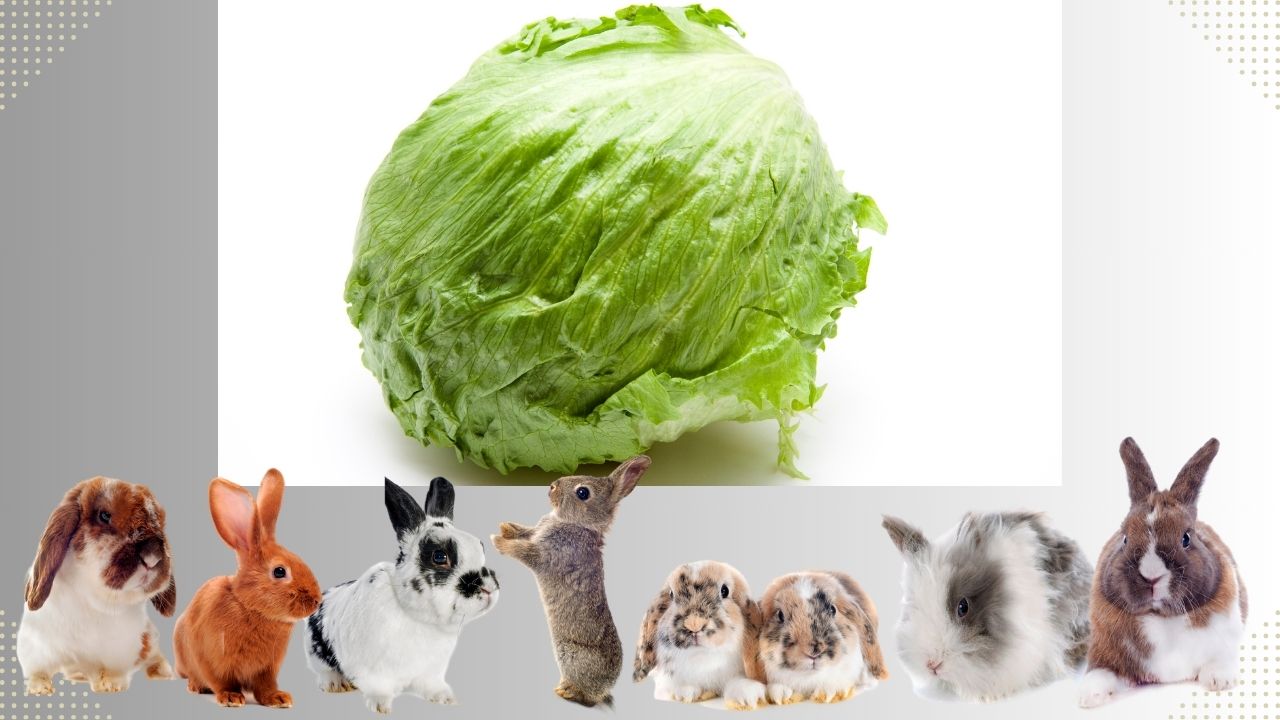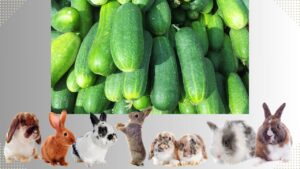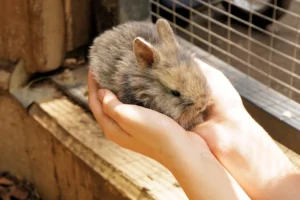Do you want to serve your furry friend the best diet possible? Then listen up! In the world of rabbit nutrition, there’s one thing you need to know: iceberg lettuce is a big no-no.
You might think it’s a crisp and refreshing choice, but for rabbits, it’s like a hidden danger lurking in their bowl. In this article, we’ll uncover the truth behind why rabbits can’t have iceberg lettuce and explore the healthier alternatives you can offer instead.
Get ready to become a rabbit food expert!
In This Article
- 1 Key Takeaways
- 2 The Nutritional Needs of Rabbits
- 3 The Digestive System of Rabbits
- 4 Potential Risks of Iceberg Lettuce for Rabbits
- 5 Alternatives to Iceberg Lettuce for Rabbits
- 6 Common Misconceptions About Rabbit Diets
- 7 Recommended Leafy Greens for Rabbits
- 8 Signs of Iceberg Lettuce Toxicity in Rabbits
- 9 How to Safely Introduce New Foods to Rabbits
- 10 Frequently Asked Questions
- 10.1 Can Rabbits Eat Other Types of Lettuce Besides Iceberg?
- 10.2 What Are Some Signs of Iceberg Lettuce Toxicity in Rabbits?
- 10.3 Are There Any Alternative Leafy Greens That Are Safe for Rabbits?
- 10.4 How Can I Safely Introduce New Foods to My Rabbit’s Diet?
- 10.5 Are There Any Common Misconceptions About What Rabbits Can Eat?
Key Takeaways
- Iceberg lettuce lacks essential nutrients and fiber required for optimal rabbit health.
- Excessive consumption of iceberg lettuce can lead to diarrhea, dehydration, and gastrointestinal issues in rabbits.
- It is important to limit the amount of iceberg lettuce in a rabbit’s diet and instead incorporate a variety of leafy greens like romaine or kale.
- Consult with a veterinarian for personalized dietary recommendations for rabbits.
The Nutritional Needs of Rabbits
You should feed your rabbit a balanced diet that meets their nutritional needs. Rabbit health is greatly influenced by their diet, so it’s important to understand their specific dietary requirements.
In the wild, rabbits primarily consume grasses, leafy greens, and hay, which provide essential nutrients like fiber, vitamins, and minerals. These elements are crucial for maintaining optimal rabbit health and preventing common health issues such as dental problems and gastrointestinal disorders.
It’s recommended to offer a variety of fresh vegetables, such as carrots, kale, and spinach, in moderation. However, certain foods like iceberg lettuce should be avoided as they’ve low nutritional value and can lead to diarrhea.
Additionally, high-quality rabbit pellets should be included in their diet to ensure they receive all the necessary nutrients. Providing a well-balanced diet is key to supporting your rabbit’s overall health and well-being.
The Digestive System of Rabbits
Eating a high-fiber diet is essential for rabbits, as it helps to maintain their digestive system’s health and prevents issues like gastrointestinal stasis. Understanding the anatomy of rabbits can provide insights into their food preferences and digestive processes. Rabbits have a unique digestive system that is designed to efficiently process fiber-rich foods, such as hay and leafy greens. Unlike humans, rabbits cannot vomit or burp, which makes it even more crucial for them to consume a high-fiber diet to prevent blockages in their intestines.
To better understand the digestive system of rabbits, let’s take a look at the different parts involved and their functions:
| Digestive System Component | Function |
|---|---|
| Mouth | Breaks down food into smaller pieces through chewing |
| Stomach | Initial breakdown of food through muscle contractions |
| Small Intestine | Absorbs nutrients from food |
| Cecum | Ferments fiber and extracts nutrients |
| Large Intestine | Reabsorbs water and forms fecal pellets |
| Anus | Eliminates waste from the body |
Understanding the complexities of a rabbit’s digestive system can help us make informed decisions about their diet and ensure their overall health and well-being.
Potential Risks of Iceberg Lettuce for Rabbits
Having too much iceberg lettuce can pose a significant risk to your rabbit’s health due to its high water content and low nutritional value. While rabbits may enjoy the taste and crunch of iceberg lettuce, it lacks the essential nutrients necessary for their well-being.
Here are a few reasons why you should limit your rabbit’s consumption of iceberg lettuce:
- Limited Nutritional Value:
- Iceberg lettuce lacks the necessary vitamins and minerals that rabbits need for optimal health.
- It doesn’t provide sufficient fiber, which is crucial for proper digestion.
- Potential Health Risks:
- The high water content in iceberg lettuce can lead to diarrhea, dehydration, and imbalances in electrolytes.
- Consuming excessive amounts of iceberg lettuce can cause bloating and gastrointestinal issues.
To ensure your rabbit’s well-being, it’s important to provide a balanced diet that includes a variety of leafy greens, vegetables, and hay. Remember to always consult with a veterinarian for guidance on proper portion sizes and potential health benefits for your furry friend.
Alternatives to Iceberg Lettuce for Rabbits
Instead of relying solely on iceberg lettuce, try incorporating a variety of leafy greens such as romaine or kale into your rabbit’s diet. Leafy greens provide essential nutrients and hydration for rabbits, promoting overall health and well-being. By offering a diverse range of leafy greens, you ensure that your rabbit receives a balanced and varied diet.
Rotating the types of greens you feed your rabbit is also important, as it prevents the overconsumption of certain nutrients and helps prevent boredom. To further enhance your rabbit’s diet, it is crucial to include high-quality hay.
Hay is an essential component of a rabbit’s diet, providing necessary fiber for proper digestion and dental health. Remember to introduce new foods gradually and consult with a veterinarian for personalized dietary recommendations for your rabbit.
Common Misconceptions About Rabbit Diets
To clarify common misconceptions about rabbit diets, remember that variety and balance are key when it comes to providing your furry friend with a healthy and nutritious meal.
There are common myths about rabbit diets that need to be debunked, especially when it comes to feeding them iceberg lettuce. Contrary to popular belief, feeding rabbits iceberg lettuce can pose risks to their health. Here are some reasons why iceberg lettuce should be avoided:
- Low nutritional value: Iceberg lettuce lacks essential nutrients that rabbits need to thrive, such as vitamins A and C.
- High water content: Excessive consumption of iceberg lettuce can lead to diarrhea and dehydration in rabbits.
Instead, focus on providing a balanced diet that includes a variety of fresh hay, leafy greens, vegetables, and a small amount of pellets. This will ensure your beloved rabbit receives the necessary nutrients for optimal health.
Recommended Leafy Greens for Rabbits
You should include a variety of leafy greens in your rabbit’s diet, such as kale, spinach, and romaine lettuce.
Leafy greens are an important component of a rabbit’s diet, as they provide essential nutrients and health benefits.
These greens are rich in vitamins and minerals, including vitamin A, vitamin C, and calcium, which are necessary for your rabbit’s overall health and well-being.
Leafy greens also contain high levels of fiber, which aids in digestion and helps prevent gastrointestinal issues.
To incorporate leafy greens into your rabbit’s diet, you can offer them as fresh, washed, and chopped leaves.
It’s recommended to introduce new greens gradually to prevent digestive upset.
Remember to always provide clean, fresh water alongside the leafy greens to ensure proper hydration for your rabbit.
Signs of Iceberg Lettuce Toxicity in Rabbits
Sometimes, rabbits may exhibit symptoms of toxicity if they frequently consume iceberg lettuce, so it’s important to be aware of the signs and take necessary precautions. Iceberg lettuce contains lactucarium, a compound that can cause diarrhea, bloating, and gas in rabbits. If your rabbit shows any of these symptoms after eating iceberg lettuce, it’s crucial to seek veterinary advice immediately.
To prevent iceberg lettuce toxicity in rabbits, consider the following tips:
- Limit iceberg lettuce consumption and opt for safer leafy greens such as romaine lettuce, bok choy, or cilantro.
- Introduce new foods slowly to your rabbit’s diet to prevent sudden digestive issues.
How to Safely Introduce New Foods to Rabbits
The key to safely introducing new foods to rabbits is by gradually incorporating them into their diet and monitoring for any adverse reactions. When transitioning to new foods, it’s important to follow a feeding schedule to ensure a smooth transition and minimize the risk of digestive issues.
Start by introducing small amounts of the new food alongside their regular diet. Observe your rabbit for any signs of discomfort or digestive upset, such as diarrhea or bloating. If there are no adverse reactions, gradually increase the amount of the new food over a period of one to two weeks.
It’s also essential to provide a diverse and balanced diet for your rabbit, including a variety of fresh vegetables, high-quality hay, and a limited amount of pellets. Remember to consult with a veterinarian to ensure that the new foods you plan to introduce are suitable for your rabbit’s specific dietary needs.
Frequently Asked Questions
Can Rabbits Eat Other Types of Lettuce Besides Iceberg?
Rabbits can eat various types of lettuce besides iceberg. It’s beneficial to provide them with a varied diet to ensure they receive a range of nutrients. Different lettuces have varying nutritional values, so it’s important to research which ones are safe and provide the necessary nutrients.
What Are Some Signs of Iceberg Lettuce Toxicity in Rabbits?
Did you know that iceberg lettuce can be toxic to rabbits? It’s important to recognize the signs of toxicity, such as diarrhea and decreased appetite. Feeding them this lettuce can be dangerous.
Are There Any Alternative Leafy Greens That Are Safe for Rabbits?
Leafy greens provide essential nutrients for rabbits, such as vitamin A and fiber. To ensure their safety, wash and prepare them properly by removing any dirt or pesticides. Avoid iceberg lettuce due to potential toxicity.
How Can I Safely Introduce New Foods to My Rabbit’s Diet?
When introducing new foods to your rabbit’s diet, it’s important to take it slow. Start by offering small amounts and gradually increase over time. This helps prevent digestive issues and potential health risks.
Are There Any Common Misconceptions About What Rabbits Can Eat?
Common myths about rabbit diets can lead to potential dangers. It’s important to know what rabbits can and can’t eat. Educate yourself on their dietary needs to ensure their health and well-being.





